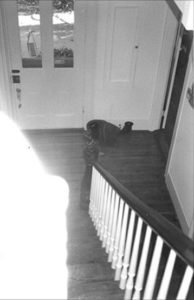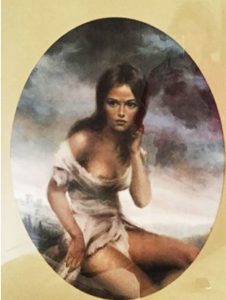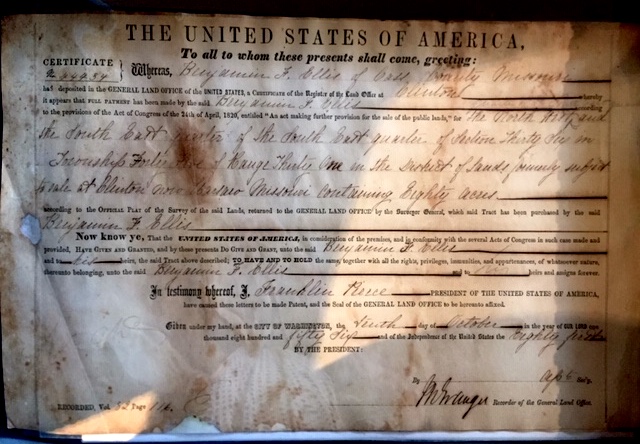Esmé: The Other Friendly Ghost
Katherine Neville’s 150-year-old Gothic house, built on the Civil War’s “Hallowed Grounds,” is also home to Esmé, a prank loving, treasure hunting ghost.
Featured on: The Line-Up · 20 Jul 2015 (Open Road Publishing)
Photo: Nicholas DeSciose
Esmé, our ghost, was first sighted on Hallowe’en Day of 2000, shortly after I’d moved into a 150-year-old Gothic house, located smack in the middle of Virginia’s “Hallowed Grounds” — the landscape where more than 80% of the battles took place in what we “foreigners” call the Civil War. (Native Virginians still refer to that historic debacle as “The Late Unpleasantness.”)
That Hallowe’en morning, I had made an appointment with the landscape designer of the local farmers’ co-op — I’ll call him “Jim” — hoping that his group might help me figure out how to lighten up our spooky entrance: Those dark rows of closed-in boxwoods and yews that marched alongside a walkway of broken stone tiles. But that morning, it was so bitterly cold that gardener Jim, after his brief landscape tour outdoors, couldn’t hold his pencil in his fingers to write anything; so we went indoors where I offered him a cup of hot tea, and a seat at the small table in my otherwise empty library. When he’d finished his sketches and estimates, he surprised me by saying, “Do you mind if I go upstairs here, and look around for a bit?”
This made me nervous. I hadn’t actually moved much furniture in yet, I’d been camping out with our pets, Tootie the cockatiel and Tyger the cat, while waiting for the movers and Karl (Dr. Karl Pribram, my spouse) to arrive in a few months.
“Well, the upstairs is empty,” I told Jim. “Did you … want to study the gardens from the windows above?”
“No, no,” he assured me. “I’m Scottish, you see. When I was just a lad, my grandmother discovered that I’ve got the Second Sight. I want to see if you have a ghost!”
This seemed perfectly natural. “I’m sure we must have,” I told him. “After all, this is an antebellum house. I’ve lived in so many places that were over 100 years old, and all of them had a ghost.”
So I accompanied him upstairs. Footsteps creaking across the old heart pine floors, Jim wordlessly explored many of the large, empty rooms. In the absence of furniture, one couldn’t tell which room was what; Jim was halfway across the room that was planned as the master bedroom, when he halted at center, and gaped at the far corner. From where I stood across the room, I could see the hair standing up on his neck.
“It’s … it’s right there,” Jim croaked, pointing toward the empty corner.
“Oh,” I said, “how exciting! I can’t wait to tell Karl. What does it look like?”
Jim admitted he couldn’t actually see the ghost, but saw a sort of shimmering effect, invisible to me. I had noticed that Tyger the cat, who loved stairways, had refused to go upstairs here by himself, unless accompanied by a human.
Esmé descending the staircase
That evening – Hallowe’en, my favorite holiday – I put candles along the front walk, turned on all the porch and inside lights, and our gothic house was visited by 87 children of all ages. Parents told me it was the first time anyone had seen lights on in the house. I told them about our newly discovered ghost. I later phoned Karl with the day’s recap, who couldn’t wait to experience the ghost himself.
A few weeks later, Karl stopped by, en route to his classes in Washington, D.C.; we explored for the ghost but saw nothing. I awakened on Sunday morning to discover that my lavish Yves St. Laurent ballgown, covered with paillettes and tulle, had vanished during the night! It had been too hard to pack for the movers, so I’d attached it to a padded hanger, suspended from the picture rails that ran around our 10-foot high ceilings. Now it had vanished: hanger and all.
After quite a search, we found the dress, still attached to its hanger, tucked beneath a library table at the far side of the house. “Our ghost must be a pretty young girl!” Karl said optimistically. “She was out dancing all night in your ballgown, just like the fairy tale princesses.”
He dubbed her ‘Esmé,’ the acronym for our phone number in Washington, D.C.
After she’d pulled a few other pranks, we decided to fix up a room for Esmé to stay put and not run around at night frightening the animals. The room we chose was the gothic room, with its high pointy windows, which seemed appropriate for a ghost, and we hung the ball gown there. That was not the room she wanted, however. There was a small room halfway upstairs on the landing; I’d stored my easels there, since it was the only room in the house with northern light to paint by.
One morning soon after, we found that everything had been thrown out of my paint room onto the landing, and my giant industrial easel had been unscrewed, flattened, and was jutting halfway out the door. The base was too wide, and it had lodged in the doorway, or it would have sledded in a crash to the bottom of the stairs.
“It appears,” said Karl, “that Esmé prefers this room on the landing. You had better move your art supplies elsewhere.”
Only a few months after our furniture finally arrived, our house became an overnight way station for my fellow writers, traveling through Washington D.C. to the many Virginia author events like Charlottesville’s Virginia Book Festival or Richmond’s prestigious James River Writers Conference.
One of our early guests was the award-winning mystery writer, Marcia Talley. I’d know Marcia for years, she’d stayed at my place in Santa Fe, and now she requested an instant tour of the new house; but as soon as we reached the small room on the landing, Marcia said, “Omigosh! The hair is standing up on my arms! Is there an attic draft here?”
“I forgot to tell you,” I apologized, “this is Esmé’s room, our ghost!”
Marcia was delighted to have been one of the first to “experience” Esmé’s presence.
Esmé did not cotton to everyone as easily as she did to Marcia or to us. We soon discovered that whenever she wanted to get our attention about something or someone, she would “disappear” things, and then — hours or days later — they would reappear exactly where knew you’d left them. My ballgown was first, but there were many others: Karl’s briefcase, containing papers he needed to grade, went missing for a weekend, and rematerialized right next to his desk; my Algerian ring disappeared twice … Tyger the cat even disappeared for two whole days, until he was located by his younger brother — locked in a closet in Esmé’s room. (No wonder he never went upstairs alone!)
A portrait Karl purchased, that he believed resembled Esmé in her former life
But Esmé’s favorite things to steal, to get our attention, were eyeglasses. Whenever eyeglasses disappeared and reappeared, we knew that Esmé wanted us to notice something. One night after a long party, a friend, “Kim,” asked to stay over in our guest room, so she wouldn’t have to drive home late at night. At 3:30 a.m., all the alarms went off all over the house: smoke alarms, burglar alarms, glass break alarms, voices saying to exit the premises … Our guest Kim was walking around the kitchen, barefoot in her bathrobe.
I said it was just some glitch; I had the security service shut the system down. In the morning, Karl and I found Kim back in the kitchen, wringing her hands, nearly in tears. “I can’t drive home today,” she explained. “During the night, my eyeglasses disappeared! Wherever I am, in a hotel, whatever, I always place my glasses on the right-hand bedside table. I put them there last night, but this morning they’re gone.”
Karl and I exchanged glances: “Esmé!” we both said in unison. Karl explained that Esmé was our ghost, who loved to steal eyeglasses, and he suggested we strip the guest bed and look underneath it, too. After a complete strip search of the bed, I found Kim’s glasses wrapped tightly inside the bedspread at the left side of the bed, in a way they might not have been found for quite awhile. (Kim never returned for a visit.)
Esmé never became violent except once: when someone sent a psychic to our house as a “gift to contact the ghost.” When the psychic was on the phone, trying to write down my street address, the lady mentioned that she planned to “exorcise your ghost, lay its spirit to rest for good and all.” Just as she spoke those words, a storm sprang up, a sudden bolt of lightning hit somewhere in the middle of town, and our connection was severed. The next morning, the psychic came walking up the street, looking for our house. When she found me sitting on the porch swing, she asked if this was the house. “I never wrote down your address,” she said. “A lightning bolt hit my house last night and the phones are still not working.” (So much for “visionary capability.” Esmé had decided not to be exorcised.)
Over the years, living in such close contact with an active spirit, we did some research on Esmé. Only five families had lived in our house since it was built in 1856, and we met the owners or descendants of all but the very first owners. We determined that our ghost might be of African descent, so we visited the Afro-Amercian Historic Society. In a few years, we had a “ghost profile”: an M.O. as we say in the mystery biz.
After numerous years of playful pranks, Esmé suddenly became very active: She stole one of Karl’s hearing aids (returned within 24 hours); my favorite necklace from Mali; many pairs of eyeglasses; some important files … each time, we would look at each other and say: “What does Esmé want???”
One morning I was lying in bed (in the room where Esmé was first sighted), and I saw some black ooze coming from the air conditioning vent over my head. I got on a ladder and touched it: black mold. I called the toxic and hazardous folks and told them I needed them to remove all the yucky, moldy, blown-in attic insulation — most carefully, by hand. (If you suck the insulation out with a vacuum, you release mold spores throughout your house. Toxic Waste was my former profession.)
For three weeks, the T&H (Toxic & Hazardous) guys labored in my attic, in extreme and dangerous heat. After the first few days, one gent came downstairs and said, “Ms. Neville, look what we found in your attic.” He handed me a piece of parchment. I opened it: it was a Land Grant Deed for land in Missouri, dated 1856 (the date of our house) and signed by President Franklin Pierce. I said, “Gentlemen, if you find any other papers up there, please put them in this bag and give them to me.”
Land grant deed for land in Missouri found in the attic
Weeks went by, and the T&H men discovered rare treasures of Virginia history, tucked away in our attic since the mid-1800s. The Library of Virginia rare books archivist came and evaluated the documents, and the librarians restored them: There were books in French, English, Italian, and German; there were more land grants; numerous artifacts, and my favorite – a ship’s provisioning manifest from the Brandywine, a ship that had borne Lafayette to America for his last voyage, and which was later sunk off the coast, during the “Late Unpleasantness.” The manifest, signed by the captain, listed all the sailors’ names and the provisions they had received.
Although Karl has died, Esmé is still on active duty at our house.
Her most recent “disappearances” include: a yo-yo from a library fundraiser I did in the 1980s; a picture of Karl’s grandmother Saita from Indonesia; a pair of my flamingo sunglasses from Venice Beach … and the trip goes on.
Katherine Neville is The New York Times-bestselling and #1 international bestselling author of The Eight and other spellbinding adventure novels. Neville’s novels have been published in more than 80 countries, and have been enriched by her 20-year career as an international computer executive and consultant, which took her to live in six countries on three continents and 26 of the United States.



